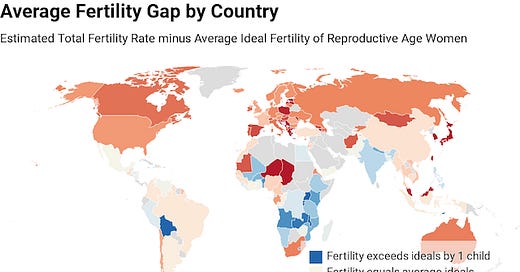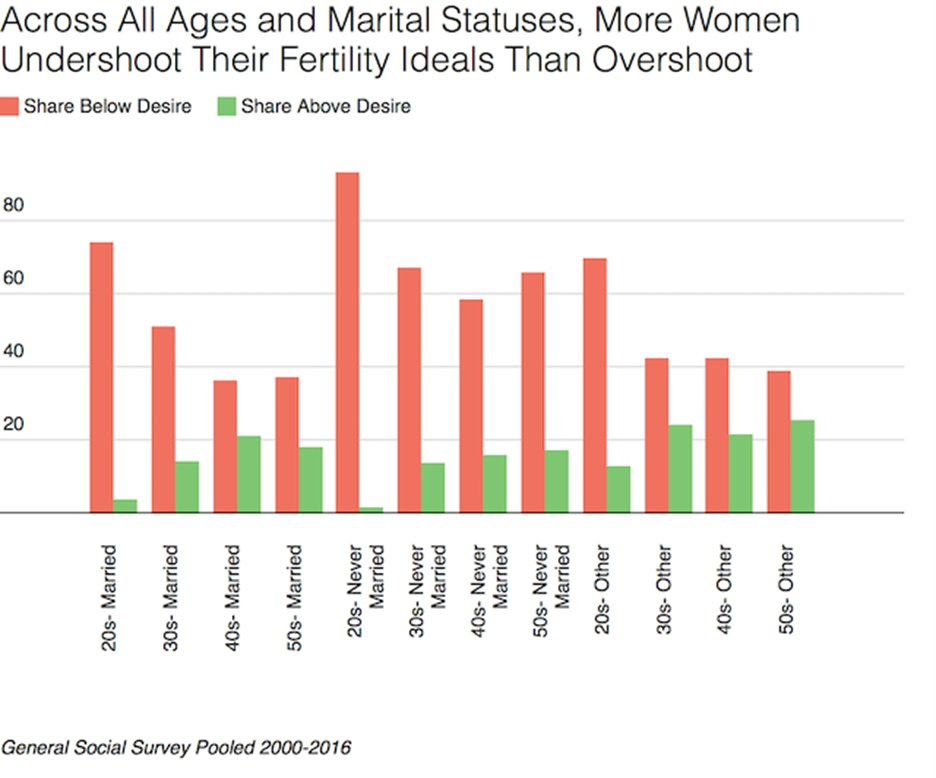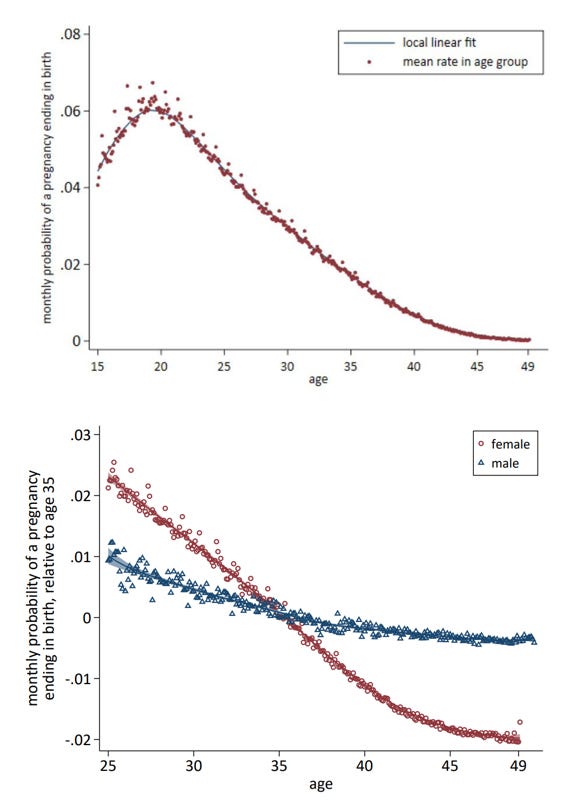The Low Hanging Fruit for Solving the Birthrate Crisis: Educating Young People about Fertility
More and more people are realizing that birth rates around the world are too low for civilizational thriving.
Where ‘replacement fertility’ is about 2.1 births per woman, the fertility rate of the US in 2023 was just 1.62. In every single OECD country except Israel, fertility rates are well below replacement, and the average among those 38 countries is just 1.42 births per woman and falling, barely more than 2/3 of the replacement rate. These developed countries account for 62% of global GDP, so the future of global progress rests heavily on whether they can sustain themselves.
Most women actually want more children than they are having
These grim numbers hide an interesting fact and a source for optimism. If you ask young women how many children they desire or what they consider to be the ideal number of children, the number is much higher. In the United States, women report wanting about 2.5 children on average, far above what they are actually having.
That's not only the case in the US. As this chart by demographer Lyman Stone shows, in most countries in the world, women are having fewer children than they would like.
It turns out, if women just had the children that they wanted to have, we would not have a birthrate crisis at all. This means that we don’t have to fear a future like in The Handmaid's Tale, where women are made to have children against their will. Happily, a society where people are able to have just the children they want to have is a society above replacement fertility!
How common is unplanned childlessness?
For women of all ages, it is far more common these days to have fewer children than they would like rather than more. See the chart below, also by Stone.
What a remarkable finding! Why? Because almost all focus in High School health class (i.e. Sex-Ed), and much of the attention with OBGyn care, is on avoiding unplanned pregnancy.
Meanwhile the much more common problem of people wanting children and not having them is barely given any thought, least of all within the realms of sex-ed and women’s health.
Why aren’t women and men having the children that they want to have?
When exploring the reasons for this, we can point to a number of causes. Education takes a long time. It is hard for many young people to get established in a good job. Houses suitable for raising a family are hard to come by and often too expensive. These are all areas to work on.
But filmmaker Stephen J. Shaw, producer of the BirthGap documentary about the global low birthrate crisis, discovered something remarkable when showing his film to college students.
Young people were shaken by the heartbreaking stories of people who had always imagined they would have kids, only to reach the end of their fertile years without any children. Most of these young people had no idea how little time they have to start a family.
More than 1/3 of young people today will end up childless, an outcome that only 5 or 10 percent of young people actually want according to surveys. As Shaw interviewed childless people, he found that most just stumbled into childlessness, usually because the necessary elements didn’t line up in time.
Many young people reprioritized their lives after watching Shaw's film, knowing that if they did not work on family goals early enough, they too might end up missing out one of the most important parts of their life.
Age as the key variable
What happened with birthrates in the US and around the world? It's quite simple. Births for teens and twenty-somethings plummeted as women and men learned to delay pregnancy while focusing on education and career-building. That seems like a good thing. Births in the 30s and beyond are rising, and often women and men in their 30s are much more ‘ready’ to have children.
But these later births just aren’t enough to make up for the births that aren’t happening earlier on. For women 35-39 and especially 40-44, the ability to have children is just far lower, even as their financial preparation will be much greater. Beyond 44, births are too rare to even make the chart.
Those births for women above age 35 would be much higher if women weren’t running into biological limits. How do we know? Remember those earlier charts. Women are not having all the children they want to have.
Technologies such as IVF are a wonderful blessing for many, including some of my closest friends. I’m all for people having children however they can! Yet the success of IVF and other assistive technologies is also dependent on age. According to Forbes, “a 2022 study found that the clinical pregnancy rate for women under 30 who’d undergone an embryo transfer was 69.4%, whereas for women ages 40 to 43, that figure declined to 9.4%.” As much as things have changed, time constraints around fertility have hardly changed at all.
How central is age to birth rates? Very! In the mid-20th century, there was a shift and people started getting hitched much younger than before (the average marriage age was 21 for women!) That shift was enough to give us the Baby Boom. Nobody planned it.
Now, as people put off family to focus on education, career and more, birth rates are the lowest that they have ever been.
Education is the low-hanging fruit for fixing the birthrate crisis
One intervention costs basically nothing, doesn’t interfere with anyone’s freedom, and helps people to get where they want to be anyway. That intervention is education about fertility and its limitations.
The charts below are from the wonderful March 2023 paper Age and Infertility Revisited by LoPalo, Geruso and Spears. They represent the best knowledge we have on the relationship between age and fecundability (the ability to conceive) for women and men.
Every high schooler and college student around the world should know these charts. Every ObGyn should be teaching their patients this information. The best way to get birth rates back to where they need to be may well be simple knowledge about age and fertility. Women and men need to know the landscape when they are young, while there is still time to organize their life around the one thing that cannot (so far) be adjusted much, their fertility window.
How often does love come at 22 or 25, only to be set aside because society says that is too soon? How often must we see or endure the heartbreak of unplanned childlessness or unexpected infertility, when things could have worked out at younger ages?
The challenges around education, work, money and relationships aren’t solved by mere knowledge of fertility constraints. But this knowledge can give many more young people a great shot at having the children they already want, and could save civilization itself.
Anti-Natal Education is a Thing
On the topic of education, there is one last point. Many teachers in the United States and elsewhere are giving anti-natal lessons in schools, under the guise of environmentalism. As unbelievable as that sounds, an organization called Population Connection, which was founded by the Paul Ehrlich under the original name Zero Population Growth, is active across the United States and Canada and trained more than 10,000 teachers in 2023 alone. The organization with roots in population control boasts that its arm Population Education “hosted over 550 workshops for educators across 44 states and in six Canadian provinces” in 2023.
In the link below, you can see my March 2024 expose’ on Population Connection, which bogus and long-debunked arguments, and a network of trained educators, to persuade millions of children in public schools to forgo having children of their own. The organization operates in plain sight, and almost nobody is paying attention.
In my March 2024 expose’ on Population Connection, which bogus and long-debunked arguments, and a network of trained educators, to persuade millions of children in public schools to forgo having children of their own. The organization operates in plain sight, and almost nobody is paying attention.
Instead, every young person should watch BirthGap and learn the truth, that in most of the world people are having too few children and birthrates are collapsing.






